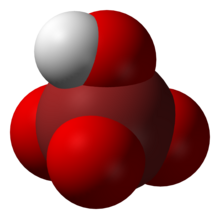Perbromic acid

| |
| Identifiers | |
|---|---|
3D model (
JSmol ) |
|
| ChEBI | |
| ChemSpider | |
PubChem CID
|
|
CompTox Dashboard (EPA)
|
|
| |
| |
| Properties | |
| BrHO4 | |
| Molar mass | 144.908 |
| Melting point | decomposes before melting, unstable as solid |
Conjugate base
|
Perbromate |
| Hazards | |
| Occupational safety and health (OHS/OSH): | |
Main hazards
|
powerful oxidizer |
Except where otherwise noted, data are given for materials in their standard state (at 25 °C [77 °F], 100 kPa).
| |
Perbromic acid is the
Perbromic acid is unstable and cannot be formed by displacement of chlorine from perchloric acid, as periodic acid is prepared; it can only be made by protonation of the perbromate ion. Perbromic acid is stable in aqueous solutions no greater than 6M. Perbromic acid solutions greater than 6M are unstable in air, where an autocatalytic decomposition of the compound will occur. Metals such as Ce4+ and Ag+ can also catalyze the compound.
Discovery
Perbromic acid was discovered through the decay of a radioactive selenate sample, SeO4−2, where bromine crystals were exposed to gamma radiation.
Safety
Perbromic acid is corrosive and an irritant, therefore it is extremely dangerous to the skin, eyes, airways, and digestive tract. Overexposure can lead to various effects such as suffocation of the lungs, loss of consciousness, and death. Due to its toxicity, prolonged or repeated exposure could also lead to organ damage via the lungs, kidneys, and intestines.
See also
Further reading
- Appelman, Evan H. (1969). "Perbromic acid and perbromates: synthesis and some properties". Inorganic Chemistry. 8 (2): 223–227. .
Citations
- Appelman, Evan H. (1969). "Perbromic acid and perbromates: synthesis and some properties". Inorganic Chemistry. 8 (2): 223–227. .
- Perbromic acid (HBrO4): properties, risks and uses - science - 2023. warbletoncouncil. https://warbletoncouncil.org/acido-perbromico-12549#menu-3.
